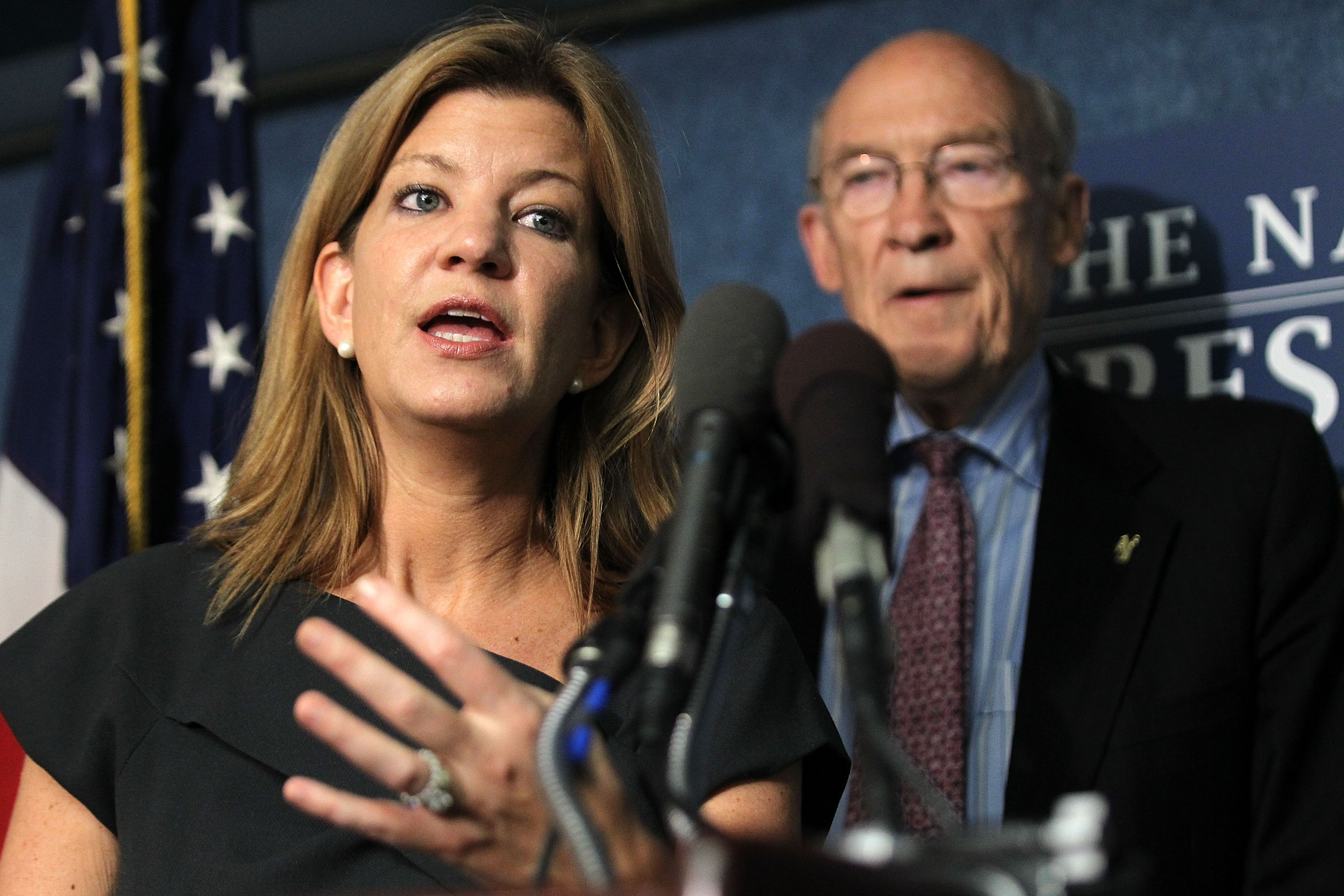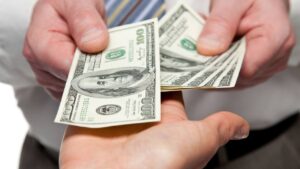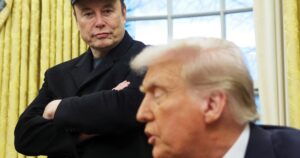https://newrepublic.com/article/161549/maya-macguineas-crfb-pandemic-austerity
This week, the first true headline-grabbing legislative battle of the Biden administration and the Democratic Congress has begun as the $1.9 trillion pandemic relief package takes center stage in the Senate. As with any piece of rock-star legislation, the bill’s movement through the Capitol has been accompanied by backstage maneuvering, bickering, and poor judgment. Senate Republican leader Mitch McConnell and his crew have been skulking around the political arena’s passageways and green rooms. They’re pushing a fishy bill of goods that tends to emerge whenever there’s a big fiscal blowout looming. Now it seems that mainstream Democrats can’t help but indulge their old weaknesses.
In a release sent last Friday, ahead of the stimulus’s passage in the House, McConnell offered up a hotshot of high-test deficit hawkery. And not just the stepped-on version that the seedy dealers from the Heritage Foundation or the American Enterprise Institute peddle in their conservative ghettos, but an austerity brand with a pedigree that’s been deemed to be totally acceptable in Washington’s polite and sophisticated quarters: Maya MacGuineas, the president of the Committee for a Responsible Federal Budget, or CRFB. In the report quoted by McConnell, MacGuineas warned that the legislation was dangerously bloated by pension bailouts, local government aid, and “poorly targeted rebate checks.” Sure enough, on Wednesday, centrist Senate Democrats forced the Biden administration and its chamber’s leadership to more strictly limit eligibility for stimulus checks that they promised to the entire country earlier in the winter.
Members of the mainstream political and media establishment are hooked on what the CRFB sells. It provides a comforting sense of economic policy savvy, a bit of soothing wonky warmth, and protection against all that nasty ideology out there. MacGuineas and the CRFB gang have been doling out media hits left and right since Biden was inaugurated on a promise of another massive spending bill. Just this February, the group (often identified as a nonpartisan nonprofit watchdog, or something similarly benign) was cited by both news and opinion writers in The New York Times, Vox, Reuters, Roll Call, The Washington Post, USA Today, Marketplace, Business Insider, and FactCheck.org, among other outlets. Last week, Washingtonian magazine named MacGuineas as one of the 250 most influential people in D.C. civil society.
But the idea that CRFB’s brand of deficit scolding is sounder than what Rick Santelli might have bellowed in the Tea Party’s founding rant is a bit like the myth that powder cocaine is somehow less dangerous than crack. The nonpartisan whiff surrounding the CRFB may render it respectable, but that doesn’t mean the group’s long-running critique of more active fiscal policy has more basis in fact than the battle cry of the House Freedom Caucus. In fact, the CRFB has consistently whiffed on the most important economic calls since the 2008 crash. But it nevertheless commands the respect of centrist policymakers and prominent opinionmongers, and America is worse off for it.
The CRFB sets the standard of neoliberal consensus austerity economics. MacGuineas came to the cause from Wall Street during the early 1990s. During the early Clinton era, leading lights of finance and economic policy frightened policymakers with scary stories about the infamous “bond vigilantes,” investors who would ruin national finances by demanding higher interest rates on U.S. Treasury bonds as the federal deficit grew. Famously, Wall Street–aligned figures like Robert Rubin used the spectre of bond vigilantes to push President Bill Clinton to abandon his 1992 campaign promises for middle-class tax cuts that would have ameliorated the pain of the early 1990s recession.
In 1995, MacGuineas left her position as a stock analyst for the Harvard Kennedy School. There she studied with Alan Simpson, former Wyoming senator and future architect of the failed “Grand Bargain” to shrink Social Security, Medicare, and Medicaid. From Harvard, her career got a boost from the patronage of billionaire investment banker and arch-austerian Pete Peterson. She joined the Peterson-funded Concord Coalition in 1997 before taking over the Peterson-funded CRFB in 2003. At CRFB, she has tirelessly worked the media circuit and the C-Suites. She famously recruited a wide range of hopeful beneficiaries in the business community for the “Fix the Debt” campaign, which aggressively encouraged the Obama administration to pivot away from economic crisis–fighting toward austerity.
At the heart of CRFB’s decades-long push for stingier federal spending lie some seriously mistaken economic ideas. As MacGuineas explained of her conversion during the early 1990s bond vigilante moment, deficit-financed relief measures like, say, Clinton’s abortive middle-class tax cuts were pure waste. “Could you really be borrowing this money with no plan? You’re not investing it, you’re not growing the economy. Is it really as irresponsible as it seems?” she told The Washington Post in a 2012 profile. “The answer is yes.”
Deficit spending, so the CRFB’s thinking goes, should only be used in the most dire emergencies for very discrete purposes, with a defined end-date. In normal times, the point of fiscal policy should be to foster national “competitiveness” rather than improve people’s lives. In testimony before a 2011 congressional hearing, MacGuineas urged legislators to stop boosting private consumption through Social Security, Medicare, and tax breaks. Instead, Congress should “reduce tax rates, and more effectively encourage work and investment, while also helping to fuel growth and reduce deficits.”
The economy can only handle so much private consumption before it “overheats” and spins off into hyperinflation, the CRFB argues. According to CRFB Senior Vice President Marc Goldwein, “Prior to the pandemic, the economy was at its potential—actually somewhat above potential based on [Congressional Budget Office] estimates.” That’s why the current proposal now before the Senate is so dangerous, the CRFB warns: If the federal government piles on more spending on top of 2020’s historically unprecedented level of stimulus, the economy could go “above potential,” sending prices skyrocketing before ultimately cratering.
The organization embraces a deflationary logic: It wants the government to suppress private consumption so a greater share of economic output accrues to the private owners of existing capital, supposedly making the country more competitive in the international fight for investment dollars. Federal spending threatens that model. The CRFB warns that government borrowing can “crowd out” the private sector in the race to attract a supposedly finite supply of investment dollars, driving interest rates up; meanwhile, it embraces the seeming common sense that simply printing money threatens hyperinflation.
Since the Reagan era, policymakers from the center left to the far right have tried to implement the CRFB’s vision. The results have been great for people who own financial assets and real estate in a handful of hot markets, or employers trying to keep labor costs down. However, the austerian policy regime has comprehensively failed to increase economic growth or even really reduce the federal debt load. Occasional deviations from deficit-hawk dogma—the George W. Bush wars and tax cuts, the 2008 bank bailouts and Obama’s subsequent stimulus, rounds of quantitative easing by the Federal Reserve, the Trump tax cuts, and the Cares Act—simply didn’t produce interest rate shocks or runaway inflation. Time and time again, history has proven the CRFB wrong.
The group has a long-standing commitment to ignoring the macroeconomic breakthroughs of heterodox economic thinkers in the tradition of John Maynard Keynes. Keynes famously demonstrated that the CRFB’s formula for growth—suppress consumption in favor of returns on capital and debt repayment—results in what he called the “paradox of thrift.” Economies ultimately run on consumption, which is a fancy way of saying people getting stuff they want. Policies that make it harder for people to satisfy their needs or desires, like shrinking Medicare or social security so individuals bear more of the burden of paying for health care and retirement, sap the system of demand and concomitant economic growth. If consumers can’t afford to buy stuff, then profits from businesses decline. People with money seeking a return then invest in speculative financial assets prone to pointless cycles of booms and busts without any increase in productivity or improvements to standards of living. It’s not irresponsible, as MacGuineas came to believe in the early 1990s, to “prime the pump” in a recession using deficit spending. It’s irresponsible not to deficit spend at an adequate level, as evidenced by the weakness and shocking inequality of the post-2008 recovery once President Obama and other Western leaders abandoned stimulus for austerity.
Likewise, the CRFB’s warnings that federal borrowing will drive up interest rates, crowd out the private sector, and put America in hock to creditors betrays a profound misunderstanding of the role of government debt in the global financial system. Investors around the world have an insatiable desire for safe dollar-denominated assets, and there’s no asset safer than a Treasury bond. Why? Because as Ayn Rand fanboy and former Fed Chairman Alan Greenspan told Congress in 2011, “The United States can pay any debt it has because we can always print money to do that. So there is zero probability of default.” In the real world, investors don’t see federal money-printing as an inflationary threat but rather a sign that returns on money lent to the government are a sure thing. More government borrowing puts more safe collateral in investors’ hands, which they can then use to finance private investments to satisfy unmet consumer demands. In other words, the federal deficit doesn’t crowd out profits but rather supplements them.
Could continued borrowing to finance the Biden stimulus or money-printing by the Fed to stabilize financial markets lead to hyperinflation, as the CRFB says? Right-wing economist Milton Friedman’s axiom that inflation is “always and everywhere a monetary phenomenon” caused by pumping too much money into the economy has certainly acquired the air of truism, but that doesn’t make it true. Inflation occurs when too much money chases too few goods, but that depends on how money is spent, not its total supply. Money in the hands of savers doesn’t contribute to inflation, because it doesn’t chase goods. So it’s no wonder that efforts by the Federal Reserve to buffet the financial system through monumental injections of cash have not led to runaway inflation. Bailouts for people who have fallen behind on rent due to pandemic-related income loss won’t lead to inflation, they will simply cancel out unexpected debts. Money in the hands of consumers will only lead to inflation when people encounter bottlenecks like an inadequate supply of housing, health care, or education. But those bottlenecks can be broken with investment in new capacity, like new home building in places people actually want to live, training of more health care providers, or creation of more university admission slots.
When commentators like Goldwein assert that the economy is “above potential” and perhaps about to overheat into uncontrollable inflation, they assume that it is far more static than it really is. More troubling, the CRFB’s estimates of the economy’s potential often rest on assumptions about the “natural rate of unemployment,” which is calculated using past demographic employment trends. That model treats centuries of employment discrimination on the basis of factors like race, sex, disability status, or age as, well, natural. Efforts to extend economic security to populations that have long suffered higher rates of unemployment than the general population, like African Americans, threaten to upset the “natural” order.
All of this is to say that if policymakers fall for what the CRFB is pushing, they will condemn the country to lower economic growth and lock in persistent inequalities, all on the basis of seriously flawed economics. Fiscal restraint in a crisis may win praise from some Washington think tank mavens and the dotty donor class, but their wan approval earns no dividends—it will come at the cost of Americans’ futures. It’s disappointing, then, that while the Biden administration and the bulk of congressional Democrats have reckoned with the centrist conventional wisdom’s decades of failure, they have not quit for good. Even as they push the latest spending package through the reconciliation process, sidestepping Mitch McConnell and the GOP’s deficit-concern trolling, they can’t help negotiating with themselves. They should know better. It’s time for the Democrats to take a truly responsible approach to the federal budget.

















